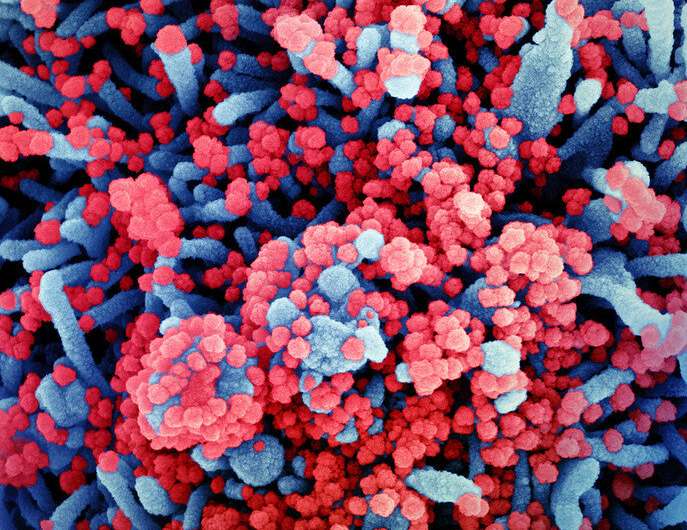Colorized scanning electron micrograph of a cell (blue) heavily infected with SARS-CoV-2 virus particles (red), isolated from a patient sample. Image captured at the NIAID Integrated Research Facility (IRF) in Fort Detrick, Maryland. Credit: NIAID
The novel coronavirus uses structures within its RNA to infect cells. Scientists have now identified these configurations, generating the most comprehensive atlas to date of SARS-CoV-2's genome.
Although contained in a long, noodle-like molecule, the new coronavirus's genome looks nothing like wet spaghetti. Instead, it folds into stems, coils, and cloverleafs that evoke molecular origami.
A team led by RNA scientist Anna Marie Pyle has now made the most comprehensive map to date of these genomic structures. In two preprints posted in July 2020 to bioRxiv.org, Pyle's team mapped structures across the entire RNA genome of the coronavirus SARS-CoV-2, using living cells and computational analyses.
SARS-CoV-2 relies on its unique RNA structures to infect people and cause the illness COVID-19. But these structures' contribution to infection and disease is often underappreciated, even among scientists, says Pyle, a Howard Hughes Medical Institute Investigator at Yale University.
"The general wisdom is that if we just focus on the proteins encoded in the virus's genome, we'll understand how SARS-CoV-2 works," Pyle says. "But for these types of viruses, RNA structures in the genome can influence their ability to function as much as encoded proteins."
Researchers can now begin to tease out just how these structures aid the virus—information that could ultimately lead to new treatments for COVID-19. Once scientists have identified RNA structures that carry out key tasks, for instance, it may be possible to devise ways to disrupt them—and interfere with infection.
More bang for the buck
Both DNA and its molecular relative RNA store information using a four-letter code. Within human cells, pairs of letters can form bonds spanning two strands of DNA. These strands twist together, forming the familiar double helix. RNA can form helices too, but in viruses such as SARS-CoV-2 and its relatives, it does so when a single molecule folds back on itself.
The result is not only stem-like double helices, but also three- and four-stranded structures, knot-like regions, and multi-stem junctions. Like building blocks, these simple configurations become the basis for even more complex architecture within the genome.
Measuring about 30,000 RNA letters, SARS-CoV-2's genome is unusually long for an RNA virus. Even so, it is still quite stubby compared to the genomes of people, plants, and even bacteria. Contorting its RNA into three-dimensional shapes gives SARS-CoV-2 another set of tools with which to compensate for a limited number of genes. "An RNA virus gets the most bang for its buck in terms of how it uses its genome," Pyle says.
Research on other viruses has teased out how they use RNA structures to do their dirty work. The hepatitis C virus, for example, uses a complex configuration of RNA to trick cells into making viral protein, according to Jeffrey Kieft, an RNA structural biologist and virologist at the University of Colorado Anschutz Medical Campus, who was not involved with Pyle's team's work. "It's kind of amazing, all the different things RNA structures can do in viral infection," he says.
Charting new territory
Pyle's group set out to decipher the configuration of SARS-CoV-2's genome with two parallel approaches. In one study, they examined the RNA's structure from within the virus's natural environment: infected cells.
It is difficult to access viral RNA within cells, where it mixes with the host's RNA. However, a quirk of SARS-CoV-2 infection—its RNA becomes unusually abundant—helped the team create a snapshot of the RNA genome's full structure. This was the first time anyone has captured such a comprehensive picture of a viral genome from within living cells. Previous efforts using HIV- and hepatitis C-infected cells did not produce enough information to create a full inventory of RNA structures.
In a related computational study, the team tried to predict how SARS-CoV-2's RNA genome, as well as other pieces of viral RNA made by the cell, might fold and interact with themselves. The two studies have not yet undergone the scientific vetting process known as peer review, but together, they reveal that SARS-CoV-2's genome has a complex, compact architecture. "The coronavirus genome has more structure than any RNA my lab has studied in the past," Pyle says.
To study any RNA virus, and SARS-CoV-2 in particular, scientists need a roadmap of its genomic landscape, Kieft says. "Dr. Pyle has created a sort of global atlas that is a great starting point for the next round of more targeted experiments," he says. "In many ways, it scratches the surface of the richness of RNA structure that probably exists in this virus. I suspect there's going to be a lot of surprises."
The mapping effort also represents a preliminary step toward new drugs that might target the virus's RNA structures. However, that road could be long. Since 2014, when his lab discovered a knot-like structure that viruses like dengue and West Nile use to evade cellular defenses, Kieft has been trying to find a way to neutralize it. He cautions that the research community is not fully geared up to identify RNA structure-disrupting drugs. "This strategy just hasn't been studied or pursued in the way that it has for proteins," he says. However, when dealing with a pandemic virus like SARS-CoV-2, "initially you try everything."
More information: Nicholas C. Huston et al. Comprehensive in-vivo secondary structure of the SARS-CoV-2 genome reveals novel regulatory motifs and mechanisms, (2020). DOI: 10.1101/2020.07.10.197079
Provided by Howard Hughes Medical Institute























